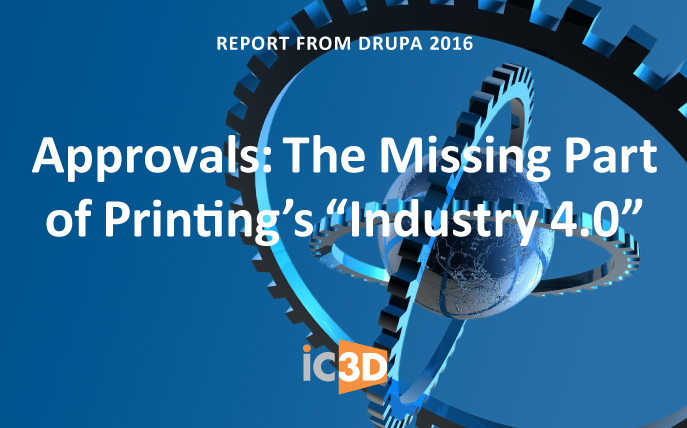As we recover from the tsunami that is drupa, many in the printing and graphics arena are left to ponder what the next few years will bring. One of the show’s hot topics—“Industry 4.0” or “Printing 4.0,” depending on who you ask—highlights the need for solutions like iC3D and packaging approval.
| MORE DRUPA NEWS COMING! We’re still gathering details and stories from the show, and will be sharing them with you in future blogs and newsletters. (SPOILER ALERT! Version 4 of iC3D attracted LOTS of attention, among vendors, resellers, and show attendees alike!) |
Briefly, Industry 4.0 is shorthand for Internet-driven interoperability and manufacturing automation. It’s not new—just the most recent stage of industrial evolution that began with things like the steam engine and accelerated with digital technology. Like all efficiency trends, it is driven by the profit motive, and the need to eliminate costly manual tasks.
For printing in general and packaging specifically, this evolution was visible as early as drupa 2000 (or Seybold 2000, for that matter). Many said that print manufacturing could become an automated, data-driven supply chain as easily as, say, auto assembly lines or beverage bottling. There were even examples of Internet-connected systems making their own, decentralized production decisions, a hallmark of Industry 4.0.
For printing, however, the road to 4.0 has been a slow one. Unlike other industries, there is a much higher proportion of human decision making involved in creating an effective printed piece—even with elaborate ticketing systems like JDF. For printed consumer packaging, the problem is even more complex.
The Human Factor
To create a “smart factory,” the avowed goal of Industry 4.0, cyber-physical systems must communicate with each other and with decision-making humans in real time. That’s no easy task in printing. Not only is it a highly-customized, one-size-does-not fit-all process, it also involves many, many different humans. Each one has interrelated decisions to make, in order to convert the designer’s or marketing person’s intent into a printed reality.
To be sure, there are many facets of printing—like the mass customization of direct mail—that are well into the “smart factory” model, as was apparent in Düsseldorf. Variable data handling, web-enabled ordering, and hands-free inkjet presses and finishing lines have brought many plants closer to lights-out manufacturing. However, when it comes to more complex, design-intensive workflows, the lights are very much on.
Seeking Approval
In printing, the approval process has long been a manual step. Slowly, with the arrival of virtual proofing and color standards like CxF, pioneered by CGS, a physical proof or printout is less important. As virtual versions of simple printed products are delivered to remote displays via the Internet, decision makers can be involved whenever necessary—without slowing down the automated parts of the process.
Consumer packaging, alas, is far more difficult than publishing or commercial printing. By definition, packaging approval involves complex surfaces and multiple viewing angles. They also involve many more decision points—from brand marketing and designers to legal teams as well as manufacturing and materials specialists.
All this requires a system that can simulate finished projects in virtual, three-dimensional terms, which is exactly what iC3D does. Other aspects of manufacturing—like platemaking, press operations, and finishing—can be interconnected and process-driven, but packaging approval will always require a “high-touch” approach from many human decision makers.
Fortunately, iC3D is well on the way to becoming a good citizen in the Industry 4.0 world. As long as humans need to visualize and approve their printed packaging, 3D visualization will make that process an efficient one.






